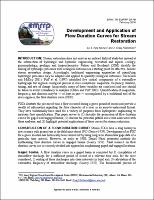Please use this identifier to cite or link to this item:
https://hdl.handle.net/11681/4017| Title: | Development and application of flow duration curves for stream restoration |
| Authors: | McKay, S. Kyle Fischenich, J. Craig, 1962- |
| Keywords: | Hydraulics Hydrodynamics Stream restoration Environmental management Environmental restoration Assessment Evaluation Flow duration curve |
| Publisher: | Engineer Research and Development Center (U.S.) |
| Series/Report no.: | Technical Note (Ecosystem Management and Restoration Research Program (U.S.)) ; no. ERDC TN-EMRRP-SR-49 |
| Description: | Technical Note Stream restoration does not exist as an isolated field of study but instead at the intersection of hydrologic and hydraulic engineering, terrestrial and aquatic ecology, geomorphology, geology, and biogeochemistry. Palmer and Bernhardt (2006) identify the linking of hydrologic processes with ecological outcomes as a starting point for effective, holistic stream restoration design. Accordingly, traditional engineering approaches of quantifying hydrologic processes may be adapted and applied to quantify ecological outcomes (Fischenich and McKay 2011). Poff et al. (1997) identified five critical components of a streamflow hydrograph that regulate ecological process in river ecosystems: magnitude, frequency, duration, timing, and rate of change. Importantly, many of these variables are correlated and care should be taken to avoid redundancy in analyses (Olden and Poff 2003). Quantification of magnitude, frequency, and duration may be — at least in part — accomplished by a traditional tool of the river engineer, the flow duration curve (FDC). FDCs illustrate the percent of time a flow occurred during a given period of record and provide a wealth of information regarding the flow character of a river in an easy-to-understand format. They have traditionally been used for a variety of purposes from hydropower engineering to instream flow quantification. This paper serves to (1) describe the generation of flow duration curves for gaged and ungaged basins; (2) discuss the potential pitfalls and errors associated with these analyses; and (3) highlight potential applications of these curves for stream restoration. |
| Gov't Doc #: | ERDC TN-EMRRP-SR-49 |
| Rights: | Approved for public release; distribution is unlimited |
| URI: | http://hdl.handle.net/11681/4017 |
| Appears in Collections: | Technical Note |
Files in This Item:
| File | Description | Size | Format | |
|---|---|---|---|---|
| ERDC-TN-EMRRP-SR-49.pdf | 1.68 MB | Adobe PDF |  View/Open |